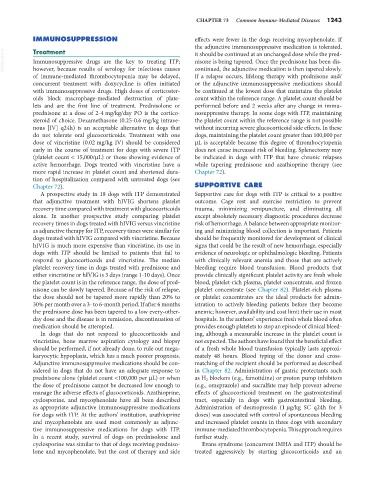Page 1271 - Small Animal Internal Medicine, 6th Edition
P. 1271
CHAPTER 73 Common Immune-Mediated Diseases 1243
IMMUNOSUPPRESSION effects were fewer in the dogs receiving mycophenolate. If
the adjunctive immunosuppressive medication is tolerated,
Treatment
VetBooks.ir Immunosuppressive drugs are the key to treating ITP; it should be continued at an unchanged dose while the pred-
nisone is being tapered. Once the prednisone has been dis-
however, because results of serology for infectious causes
If a relapse occurs, lifelong therapy with prednisone and/
of immune-mediated thrombocytopenia may be delayed, continued, the adjunctive medication is then tapered slowly.
concurrent treatment with doxycycline is often initiated or the adjunctive immunosuppressive medications should
with immunosuppressive drugs. High doses of corticoster- be continued at the lowest dose that maintains the platelet
oids block macrophage-mediated destruction of plate- count within the reference range. A platelet count should be
lets and are the first line of treatment. Prednisolone or performed before and 2 weeks after any change in immu-
prednisone at a dose of 2-4 mg/kg/day PO is the cortico- nosuppressive therapy. In some dogs with ITP, maintaining
steroid of choice. Dexamethasone (0.25-0.6 mg/kg intrave- the platelet count within the reference range is not possible
nous [IV] q24h) is an acceptable alternative in dogs that without incurring severe glucocorticoid side effects. In these
do not tolerate oral glucocorticoids. Treatment with one dogs, maintaining the platelet count greater than 100,000 per
dose of vincristine (0.02 mg/kg IV) should be considered µL is acceptable because this degree of thrombocytopenia
early in the course of treatment for dogs with severe ITP does not cause increased risk of bleeding. Splenectomy may
(platelet count < 15,000/µL) or those showing evidence of be indicated in dogs with ITP that have chronic relapses
active hemorrhage. Dogs treated with vincristine have a while tapering prednisone and azathioprine therapy (see
more rapid increase in platelet count and shortened dura- Chapter 72).
tion of hospitalization compared with untreated dogs (see
Chapter 72). SUPPORTIVE CARE
A prospective study in 18 dogs with ITP demonstrated Supportive care for dogs with ITP is critical to a positive
that adjunctive treatment with hIVIG shortens platelet outcome. Cage rest and exercise restriction to prevent
recovery time compared with treatment with glucocorticoids trauma, minimizing venipuncture, and eliminating all
alone. In another prospective study comparing platelet except absolutely necessary diagnostic procedures decrease
recovery times in dogs treated with hIVIG versus vincristine risk of hemorrhage. A balance between appropriate monitor-
as adjunctive therapy for ITP, recovery times were similar for ing and minimizing blood collection is important. Patients
dogs treated with hIVIG compared with vincristine. Because should be frequently monitored for development of clinical
hIVIG is much more expensive than vincristine, its use in signs that could be the result of new hemorrhage, especially
dogs with ITP should be limited to patients that fail to evidence of neurologic or ophthalmologic bleeding. Patients
respond to glucocorticoids and vincristine. The median with clinically relevant anemia and those that are actively
platelet recovery time in dogs treated with prednisone and bleeding require blood transfusion. Blood products that
either vincristine or hIVIG is 3 days (range 1-10 days). Once provide clinically significant platelet activity are fresh whole
the platelet count is in the reference range, the dose of pred- blood, platelet-rich plasma, platelet concentrate, and frozen
nisone can be slowly tapered. Because of the risk of relapse, platelet concentrate (see Chapter 82). Platelet-rich plasma
the dose should not be tapered more rapidly than 20% to or platelet concentrates are the ideal products for admin-
30% per month over a 3- to 6-month period. If after 6 months istration to actively bleeding patients before they become
the prednisone dose has been tapered to a low every-other- anemic; however, availability and cost limit their use in most
day dose and the disease is in remission, discontinuation of hospitals. In the authors’ experience fresh whole blood often
medication should be attempted. provides enough platelets to stop an episode of clinical bleed-
In dogs that do not respond to glucocorticoids and ing, although a measurable increase in the platelet count is
vincristine, bone marrow aspiration cytology and biopsy not expected. The authors have found that the beneficial effect
should be performed, if not already done, to rule out mega- of a fresh whole blood transfusion typically lasts approxi-
karyocytic hypoplasia, which has a much poorer prognosis. mately 48 hours. Blood typing of the donor and cross-
Adjunctive immunosuppressive medications should be con- matching of the recipient should be performed as described
sidered in dogs that do not have an adequate response to in Chapter 82. Administration of gastric protectants such
prednisone alone (platelet count <100,000 per µL) or when as H 2 blockers (e.g., famotidine) or proton pump inhibitors
the dose of prednisone cannot be decreased low enough to (e.g., omeprazole) and sucralfate may help prevent adverse
manage the adverse effects of glucocorticoids. Azathioprine, effects of glucocorticoid treatment on the gastrointestinal
cyclosporine, and mycophenolate have all been described tract, especially in dogs with gastrointestinal bleeding.
as appropriate adjunctive immunosuppressive medications Administration of desmopressin (1 µg/kg SC q24h for 3
for dogs with ITP. At the authors’ institution, azathioprine doses) was associated with control of spontaneous bleeding
and mycophenolate are used most commonly as adjunc- and increased platelet counts in three dogs with secondary
tive immunosuppressive medications for dogs with ITP. immune-mediated thrombocytopenia. This approach requires
In a recent study, survival of dogs on prednisolone and further study.
cyclosporine was similar to that of dogs receiving predniso- Evans syndrome (concurrent IMHA and ITP) should be
lone and mycophenolate, but the cost of therapy and side treated aggressively by starting glucocorticoids and an

